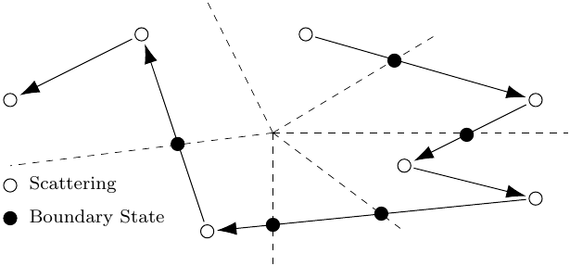 |
|
||||
BiographyMarkus Kampl was born in Vienna, Austria, in 1988. He studied electrical engineering at the TU Wien, where he joined the Institute for Microelectronics in October 2012. He received the degree of Diplomingenieur and the PhD in November 2015, respectively April 2019. Currently, Markus is a Postdoctoral researcher in the CDL for Single-Defect Spectroscopy and his work focuses on developing a simulation framework to calculate the carrier mobility in power MOSFETs. |
|||||
Improved Sampling Algorithms for Monte Carlo Device Simulation
Monte Carlo (MC) is a widely used method to estimate integrals and the solution of integral equations statistically. In semiconductor physics, the method is often used to estimate the solution of the Boltzmann transport equation [1] [2]. In stationary simulations, statistical averages can be obtained by the so-called before-scattering method. This method, however, becomes ineffective when applied to small devices where the mean-free-path is larger than the average size of the mesh cells. We present a new method that is better suited to small devices and can even be applied in the quasi-ballistic transport regime.
The before-scattering method samples particles along a trajectory before a scattering event takes place. The sample values are weighted with the reciprocal of total scattering rate [1][4][5]. When the simulation domain is decomposed into Voronoi volumes, averages of local attributes can be built for every discretization volume separately [6][7]. The boundary method samples particle states along trajectories whenever a particle crosses an interface between two Voronoi volumes. The sample values have to be weighted with the reciprocal of the velocity component perpendicular to the interface [3]. The benefit of this method is that the number of sampling points now depends on the surface of a Voronoi box and not on the volume. With mesh refinement, the surface of a cell scales more favorably than the volume. The samples obtained by the before-scattering method and from the boundary method can be combined. This combination of samples gives a smaller statistical error than those of each method individually.
[1] C. Jungemann et al., Springer, 2003
[2] C. Jacoboni et al., Springer, 1989.
[3] M. Lundstrom, Cambridge University Press, 2000.
[4] C. Jacoboni et al., Rev. Mod. Phys.55, 1983.
[5] H. Kosina, PhD thesis. Technische Universität Wien, 1992.
[6] E. Sangiorgi et al., IEEE Transactions on Computer-Aided Design of Integrated Circuits and Systems, 1988.
[7] M. Kampl, PhD thesis. Technische Universität Wien, 2019.

Fig. 1: Boundary and before-scattering method sampling in a device. The dashed lines are the boundaries between the Voronoi volumes.


